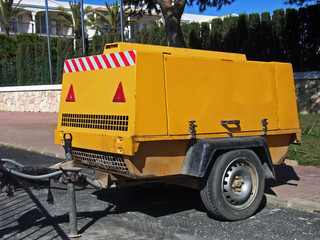Portable Generator vs. Standby
 There are two general categories of generators: portable and standby. Portable generators can be moved from place to place and have more versatility. Standby generators are stationary, installed in one location permanently, and are hooked up to existing power sources, such as electric or natural gas utility lines.
There are two general categories of generators: portable and standby. Portable generators can be moved from place to place and have more versatility. Standby generators are stationary, installed in one location permanently, and are hooked up to existing power sources, such as electric or natural gas utility lines.
Below, we breakdown the important purchasing considerations to help you decide which you need:
Portable generators
Portable generators are designed to provide power wherever you need it. There are two ways portable generators are operated. They can run on fuel, such as natural gas, propane, biogas and diesel, or are run off of a battery that is part of the unit. Electric portable generators are great for short-term tasks. For longer use, fuel portable generators provide optimum efficiency to run hand tools, lighting sets, clean up machines, bench-top tools and temporary facilities.
Portable generators are less reliable than their standby counterparts, making maintenance a key factor in the machine’s longevity. The average life span of a portable generator is 10,000 to 25,000 hours, depending on your care of the unit. The warranty or maintenance agreements seldom extend beyond one year of ownership.
Maintenance tips:
- Be sure to check connections and bolts, fluids, and spark plugs twice a year.
- For electric models, make sure the distilled water in the battery is topped off at least once a month.
- Always operate a portable generator outside and away from heavily trafficked areas.
Portable generators can cost as little as a few hundred dollars to several thousand dollars. The price depends on size, wattage, and other features. The most popularly reviewed brands include Honda, Champion, Generac and Yamaha.
Standby generators
Standby generators are permanently installed outside homes, offices, businesses and other facilities. Installation is performed by professional companies and may require a permit so be sure to do the homework for your area. They also have fuel and electric options.
Electric standby generators will be wired into the electric service and panel that are in the facility. There are more options for motor powered generators. It can be connected to a natural gas or propane (LP) tank. There are diesel options in which the generator is on a trailer with its own supply that can be hauled for refilling. Bio gas standby generators feature a significantly reduced carbon footprint and are the most fuel efficient option.
Provided the generator can supply the necessary wattage, it can power an entire house, business, hospital or emergency response facility. Maintenance should be performed annually by a trained team similar to the installers.
The downside to standby generators is noise and emissions. Fuel powered generators produce both, which may be an issue depending on noise standards in your community or new government environmental regulations.
Cost of a standby generator varies greatly based on its capacity. One can cost as little as $1500 or move into the tens of thousands of dollars. Generac consistently gets high ratings and reviews for its standby offerings while Honda and Briggs & Stratton also have popular, quality offerings.
Choosing the right generator
The right generator for you depends on how much power you need and where you need it. If your business is in an area where you may lose power for days at a time due to weather events, a fuel powered standby generator with an independent tank is your best option to keep your business running like normal. If you travel frequently and use power, a portable generator gives you flexibility along with your creature comforts. Whatever you want to do, there is a generator out there that can make it happen.
Get Quotes
- We contact sellers
- They compete for your business